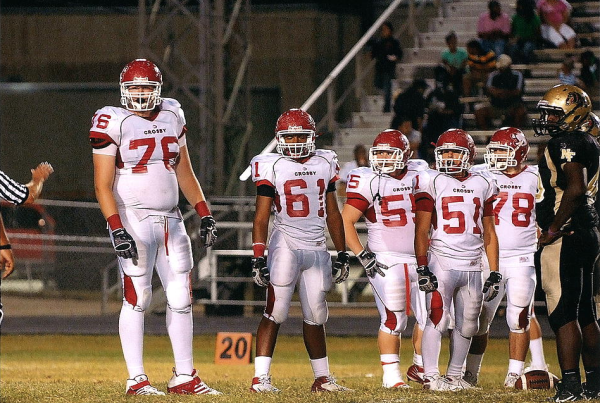This story originally appeared on Houston Public Media.
On a recent school morning, 22 pre-kindergarteners gathered on a rainbow-colored rug.
They counted how many words were in a sentence on the board.
Their teacher Atenea Raptis gave them high marks for counting all six words.
“Yes, we counted six words?” she asked in Spanish.
“Kiss your brain!”
All the children kissed their thumbs and then touched their thumbs to their foreheads.
“It’s feedback that you’re doing great,” Raptis explained.
Her class is an example of the types of programs that Alief Superintendent HD Chambers wants to invest in.
The class is taught mostly in Spanish so that students learn in their native language first and can transfer the skills to English later.
Raptis said her students — whom she calls “mis amores” — have made tremendous progress during the year. Many children started the year not using many words. Now many know their letters and sounds. Some pre-K students are even reading on a kindergarten level.
“They’re like little sponges. Anything you give them they will get it,” Raptis said.
Research shows that a quality start in pre-kindergarten can prepare students for their academic careers.
“A quality, full-day pre-K program can make a tremendous impact on a student’s future success,” Chambers said.
He said he wants to expand from half-day pre-K to full-day.
He also wants to enroll all the students in Alief who qualify. The district currently enrolls about 2,400 pre-K students. But more than a 1,000 kids are missing out.
But Chambers doesn’t have the money for that.
“You know, full-day pre-K right now is not funded in Texas. We only fund it for half a day,” he said.
Texas funds pre-K through grants that are separate from the school finance formula for K-12 grades. Those grants were cut in 2011 and have been partly restored.
This is only the start of this superintendent’s budget problems.
Before crunching the numbers, Chambers said it’s important to consider the students in Alief.
They have a lot of challenges.
Eight in every 10 students are from low-income families. Four out of every 10 students are learning English.
“And we have about 90 different languages spoken in our district. So it’s kind of a melting pot. It’s an international district if there ever was one,” Chambers added.
The student needs are factored into the state’s funding formula: Chambers gets extra money for students who are learning English and who are from low-income families.
But the state’s formulas for that extra money — technically called a weight — are outdated. They haven’t been updated since 1984.
“If we’re trying to meet needs in 2014 with formulas that we haven’t revised in 30 years, that’s a disconnect,” saidDavid Thompson, the attorney for a large coalition of school district plaintiffs, including Fort Bend, Houston and Pearland.
“That would be like trying to build a bridge and trying to use 1984 cost schedules for labor and steel and concrete. It wouldn’t be a very successful undertaking,” Thompson added.
The weight for English-learners is currently 10 percent extra; for low-income students, it’s 20 percent. Research shows that they should be at least doubled.
When Alief Superintendent Chambers compared how much he receives for those students versus how much he spends to support them, he said that he falls short by $1,300 per student on average.
“It doesn’t take a mathematician to figure out that you’re not receiving enough money to cover the cost of what it’s costing you to educate them,” he said.
That is one reason why Chambers has budget problems. He was one of many superintendents who testified at the latest school finance trial.
Another reason is on the revenue side.
Alief is considered a property-poor school district.
Nearby, where Chambers used to be superintendent, there’s a property-wealthy school district, called Stafford Municipal School District.
Scott Hochberg, a former state lawmaker and expert in the state’s finance system, said that Stafford has an edge because it has more commercial property wealth.
One example of that wealth is a large shopping center next to U.S. 59. The land is owned by the top property tax payer to the Stafford school district.
“Money for schools is primarily generated from property taxes and some school districts have substantially more property to tax than others do. Stafford’s one of the ones that has more property to tax,” Hochberg explained outside that shopping center.
In fact, Stafford can have a lower tax rate and still raise more money for schools.
Back in Alief, Hochberg said that the tax rate is higher just to keep up. An even higher tax rate would need voters’ approval, according to the state’s rules, which is not an easy sell politically.
Hochberg compared the system to football.
“It’s sort of as if the NFL salary cap consistently gave more money to a few of the teams,” said Hochberg, who now teaches education policy at Rice University.
“It doesn’t mean they would always reach the Super Bowl. But year after year after year, they would have an advantage and the other teams would find that not fair,” he said.
For school districts, Hochberg said it means some can afford more experienced teachers, smaller classes and more programs.
Consider pre-K again.
The Stafford school district can fund full-day pre-K and open it to all students.
It uses state funds for accelerated learning or intensive instruction for that. In an email, the district’s finance director Daniel Flores said they’ve made it a priority.
“Stafford [Municipal School District] believes that a full day pre-K program is extremely beneficial to the development of a strong academic framework during the early childhood stage,” Flores wrote.
But Alief can only fund half-day for some students. It has also had to cut teacher aide positions.
So, given that research shows that a quality early education can pay off later in life, even at 4 and 5-years-old some students are starting behind their neighbors.
Support for this series was provided by “The Equity Reporting Project: Restoring the Promise of Education,” which was developed by Renaissance Journalism with funding from the Ford Foundation.















